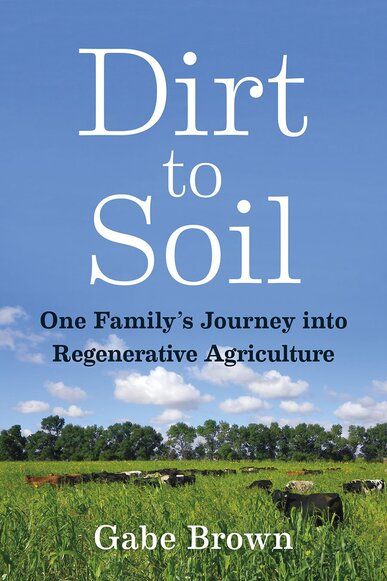
Dirt to Soil: one family's journey into Regenerative Agriculture
Gabe Brown discusses his principles of soil health and is useful to farmers and anyone concerned with food production and the state of farming.

Published by Chelsea Green, 2018
One of my favourite hymns is the harvest festival one which starts “We plough the fields and scatter the good seed on the land...” But giving up ploughing is one of the key things recommended by Gabe Brown if we want to improve soils and farm sustainably. That we need to stop this millennia old practice (though no doubt the modern form, using big machinery, is particularly destructive) is an indication of the scale of the changes we need to make in how we use land to produce food.
Gabe Brown is a farmer in North Dakota who stopped ploughing his land in 1994 because he wanted to save time and conserve moisture in the soil. He switched to ‘no-till’ methods, in which seed is drilled into the residue of the previous year’s crop, often after applying herbicides to kill off weeds. No-till cultivation methods are fairly widely practised in America, where memories of the 1930s dust bowl perhaps mean that farmer are particularly aware of the need to conserve soil, but they are increasingly used in the UK. For Gabe Brown, however, stopping ploughing was just the start of a long process of changing how he farms, one that has put the health of his soil at the heart of his farming system and meant he has created living soil from degraded, lifeless dirt.
At the start of the book Brown sets out his five principles of soil health:
- Limit disturbance, hence no ploughing. Synthetic fertilisers, herbicides, fungicides and pesticides disturb the soil chemically and should also be avoided.
- Keep the soil covered at all times – Brown uses cover crops and crop residues to protect the soil, with no bare ground at any time of year.
- Increase diversity of both plant and animal species as much as possible – his cover crop mixes now consist of at least seven different species and after starting just with cattle he now farms sheep, chickens and pigs as well.
- Keep living roots in the soil as much as possible throughout the year as they feed soil biology
- Integrate animals. Animals are always part of natural ecosystems and they have a key role to play in improving soil health.
Gabe Brown’s book is addressed to other farmers and though an easy read I struggled sometimes with the American and agricultural terminology.
However, it should be of interest to anyone concerned about how we produce our food and the state of farming. Critically he says that the most important thing is to change how you see things (p.190). One of those things, ingrained in many farmers, is that they should try to increase their yields as much as possible. Talking about his early years of practicing the conventional model of farming Brown says:
“I chased higher yield when growing crops and more pounds when raising beef. Everywhere I turned, the message of increasing production was pounded into me. Magazines, newspapers, radio, universities, extension service, agricultural agencies, everywhere and everyone was telling me that I had to produce more “to feed the world.” Stacked GMO traits, hybrid grain varieties, foliar fertilizer, seed treatment, larger equipment..... It is the same with livestock: performance-tested bulls with the highest expected progeny differences (EPDs), genome testing, total mixed rations with the latest ionophores, all designed to produce more, more, more!”
Over time he came to see that he had been chasing short term gain at the expense of his ecological resources, of the health of his soil, and therefore long term profits. Brown does a lot of talks to farmers and describes (on p.190) how once, in a talk to corn and soybean producers in Nebraska, he asked how many of them made a profit on their corn the previous year. Only one person raised their hand, but they were all planning on growing corn next year. Agriculture seems to have got itself into a treadmill of attempting to increase efficiency and yields through specialisation and expensive inputs, but low commodity prices mean that profits are slim. Farmers are only still in business because of subsidies. The key, Brown argues, is to focus on profit per acre instead of yield per acre or pounds per calf. Increasing profits per acre cannot be achieved with monocultures that rely on expensive inputs; rather it requires a diversity of enterprises that are synergistic with each other, such as one enterprise using the waste stream of another. On p. 192-193 he gives a ‘cash flow’ statement that shows how carbon (rather than money) flows through 30 ‘products’ for Brown’s Ranch. Gabe Brown, his wife, their son and his partner can manage all these different enterprises because they have radically cut down the amount of work needed by a less interventionist approach to farming, in which they let nature do more things for them. He lists some of the many things that they don’t have to do:
“we don’t have to haul and apply fertilizer, pesticides, and fungicides. We don’t need to vaccinate and worm our livestock. We don’t spend days chasing around the country to find the latest and greatest bulls, rams, and boars. We don’t pregnancy test the cowherd, pigs, or sheep. We don’t have daily chores of starting up farm equipment to haul feed to the livestock during the winter. We don’t have to spend time hauling manure from the corrals out to spread on the fields....” (p.195)
Although he has stopped using synthetic fertilizer Brown’s Ranch is not ‘organic’ as he still occasionally uses herbicides to control perennial invasive weeds: though he would rather not use them he considers an occasional herbicide pass as less damaging to the soil than ploughing. It is rather ironic that a farming system that puts soil health at its heart is not organic. When the organic movement started in the 1930s its primary concern was soil health – hence the name of the main UK organic certification organisation is the Soil Association (see The Origins of the Organic Movement, by Philip Conford, Floris Books, 2001). Perhaps it is a sign that the organic movement has to some extent lost sight of this and come to be defined by negatives - no synthetic fertilisers, no herbicides or pesticides, no GMOs etc. - rather than the positive idea that ‘the soil’s health and fertility must be maintained by encouraging the presence of humus’ (Conford, p.17). Brown (on p.74-76) proudly reports the results of a comparative study of the soils of his own and three other nearby farms. One appears to be under organic management as no synthetic fertilisers, pesticides, herbicides or fungicides are used, it relies on ploughing for weed control and to prepare the soil for seeding. The other two use minimum or no tillage and none of the three had livestock. What is striking about the results is how similar the other three are: organic matter content of 1.5-1.7 % and water infiltration rates of 0.45 to 0.7 inches per hour, for example. In contrast, these values for the soils from Brown’s Ranch were 6.9% and 30 inches per hour with nitrogen, potassium and phosphorus also an order of magnitude greater than in the other soils.
The importance of livestock for soil health is a challenge to the idea that we should stop eating meat altogether. Animals do not simply take biomass by feeding, reducing what is left: when grazing is managed in the right way it can enable the soil to produce more than it otherwise would have done, as grazing stimulate plants to pump more carbon into the soil, feeding the soil biota (p.3). Animals can also turn what would otherwise be waste into food, such as Brown’s chickens being fed grain screenings (p.86). We should stop growing grains specifically to feed to livestock, the Amazon and other forests should not be cleared to make way for cattle grazing, but it is wrong to extrapolate from the impacts of these current practices to say that therefore it would be better if we stopped livestock farming altogether (see also our review of Meat a Benign Extravagance). Instead of considering the impacts of particular foods in isolation we need to consider what is the most sustainable farming system in a particular location - from soil health, climate and biodiversity points of view - and collectively eat the products of that system. This is likely to include at least some meat and other animal products.



